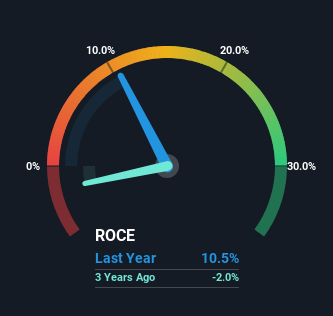Stock Analysis
- United States
- /
- Auto
- /
- NasdaqGS:LI
Returns At Li Auto (NASDAQ:LI) Are On The Way Up

Finding a business that has the potential to grow substantially is not easy, but it is possible if we look at a few key financial metrics. One common approach is to try and find a company with returns on capital employed (ROCE) that are increasing, in conjunction with a growing amount of capital employed. If you see this, it typically means it's a company with a great business model and plenty of profitable reinvestment opportunities. With that in mind, we've noticed some promising trends at Li Auto (NASDAQ:LI) so let's look a bit deeper.
Return On Capital Employed (ROCE): What Is It?
For those who don't know, ROCE is a measure of a company's yearly pre-tax profit (its return), relative to the capital employed in the business. To calculate this metric for Li Auto, this is the formula:
Return on Capital Employed = Earnings Before Interest and Tax (EBIT) ÷ (Total Assets - Current Liabilities)
0.10 = CN¥7.4b ÷ (CN¥143b - CN¥73b) (Based on the trailing twelve months to December 2023).
Therefore, Li Auto has an ROCE of 10%. By itself that's a normal return on capital and it's in line with the industry's average returns of 10%.
View our latest analysis for Li Auto

In the above chart we have measured Li Auto's prior ROCE against its prior performance, but the future is arguably more important. If you'd like to see what analysts are forecasting going forward, you should check out our free analyst report for Li Auto .
What Can We Tell From Li Auto's ROCE Trend?
The fact that Li Auto is now generating some pre-tax profits from its prior investments is very encouraging. About five years ago the company was generating losses but things have turned around because it's now earning 10% on its capital. And unsurprisingly, like most companies trying to break into the black, Li Auto is utilizing 1,654% more capital than it was five years ago. This can indicate that there's plenty of opportunities to invest capital internally and at ever higher rates, both common traits of a multi-bagger.
On a side note, we noticed that the improvement in ROCE appears to be partly fueled by an increase in current liabilities. The current liabilities has increased to 51% of total assets, so the business is now more funded by the likes of its suppliers or short-term creditors. And with current liabilities at those levels, that's pretty high.
What We Can Learn From Li Auto's ROCE
To the delight of most shareholders, Li Auto has now broken into profitability. Investors may not be impressed by the favorable underlying trends yet because over the last three years the stock has only returned 21% to shareholders. So with that in mind, we think the stock deserves further research.
One more thing to note, we've identified 2 warning signs with Li Auto and understanding them should be part of your investment process.
While Li Auto may not currently earn the highest returns, we've compiled a list of companies that currently earn more than 25% return on equity. Check out this free list here.
Valuation is complex, but we're helping make it simple.
Find out whether Li Auto is potentially over or undervalued by checking out our comprehensive analysis, which includes fair value estimates, risks and warnings, dividends, insider transactions and financial health.
View the Free AnalysisHave feedback on this article? Concerned about the content? Get in touch with us directly. Alternatively, email editorial-team (at) simplywallst.com.
This article by Simply Wall St is general in nature. We provide commentary based on historical data and analyst forecasts only using an unbiased methodology and our articles are not intended to be financial advice. It does not constitute a recommendation to buy or sell any stock, and does not take account of your objectives, or your financial situation. We aim to bring you long-term focused analysis driven by fundamental data. Note that our analysis may not factor in the latest price-sensitive company announcements or qualitative material. Simply Wall St has no position in any stocks mentioned.
About NasdaqGS:LI
Li Auto
Li Auto Inc. operates in the energy vehicle market in the People’s Republic of China.
Exceptional growth potential with flawless balance sheet.

